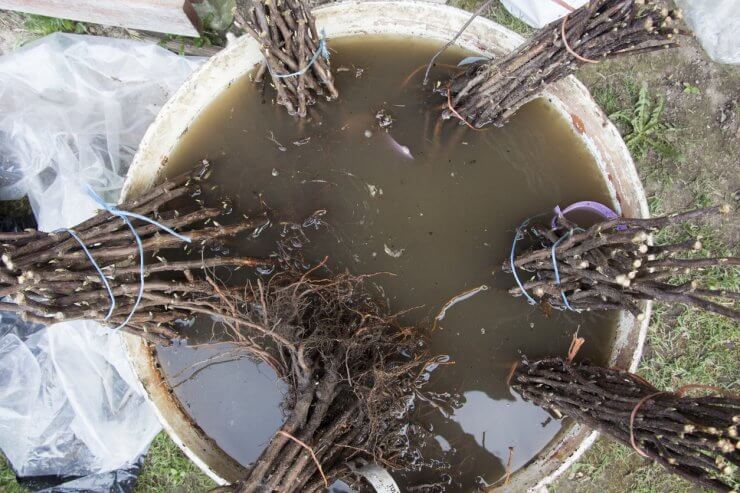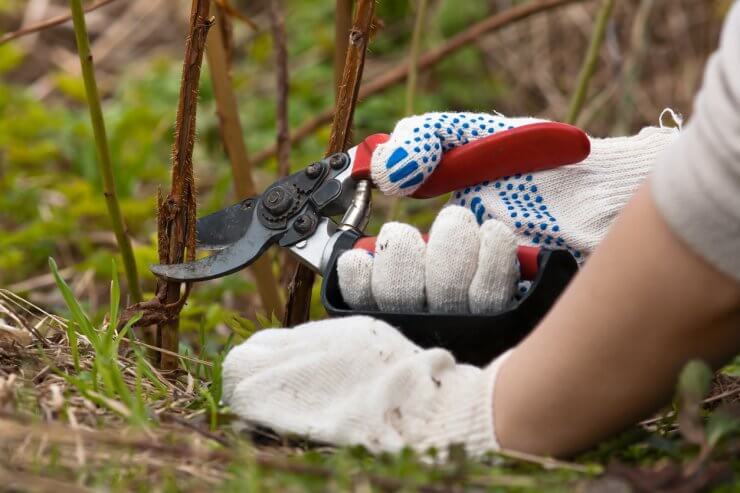Planting Your Raspberries

Soaking raspberry canes before planting
Once you have your planting location, your tools and supplies, and your plants, it’s time to start your raspberry patch. Whether you’re planting bare-root or potted plants, the key is to keep the crown of the plant 1 or 2 inches above the ground.
Soak bare root plants in lukewarm water for an hour before planting. Dig a hole based on the size of the root mass. When you place the plant in the hole spread out the roots. Try not to wrap the roots around in the hole. If any roots are particularly long or unruly, they can be trimmed off.
If planting a potted plant, make sure to loosen the root ball and cut any tightly wound roots. This will help the roots spread better once planted in the ground.
Allow new primocanes of red and yellow raspberries to spread along the row or in between plants, but not wider than 12 inches. Wider than that and the plants will be difficult to manage and harvest, and more prone to fungal diseases because of slow drying conditions.
Set black and purple raspberries 4 feet apart. Because these types do not produce root suckers, they will create what is commonly called a hill. The “hill” refers to the cluster of canes that develops from a single plant.
Pruning Your Raspberries

Pruning raspberry canes
Pruning you raspberry plants is key to cultivating them while also containing their spread.
Summer-bearing red and yellow raspberries
After the last harvest, cut all canes that have fruited (floricanes) to the ground. This will deter diseases and provide room for new growth.
Ever-bearing raspberries
Cut back the floricanes as described for summer-bearing raspberries. The primocanes that produced the fall crop should not be removed, as they will produce fruit the following summer. Prune them back in spring to about 12 inches above the support, or to the last visible node that had fruit, cutting off the dead tips.
Black and purple raspberries
When primocanes are between 24 to 30 inches in height, pinch out the tip of each shoot to induce branching. This will make the fruit easier to pick and increase production. After harvest, cut down all canes that bore fruit to ground level. Before growth begins the following spring, cut back all side branches so they are 12 to 18 inches long. Select four to five canes per hill, and prune out the rest. Tie these canes to the support system.
If you find canes popping up beyond your desired raspberry growing area, cut them to the ground with pruning shears, or simply mow them down.
Please tell us about your raspberry planting and pruning techniques in the comment section below. Have you faced any challenges with planting or pruning your raspberries? How have you handled it? Please comment below and share your experiences.


 Previous
Previous


I bought a bush and put it in a container which I left in the yard this first year. When I came back (I am not at my trailer all the time) the tips of the branches had rooted in the ground but this area does not get enough sun for them to thrive (according to what I am reading here). Should I just cut these new plants out of their soil, prune them and transplant them in a sunny place on the other side of my trailer? Do I need some type of nutrient besides leaves and compost? Or should I get more containers or plant bags and do it that way? I have never grown raspberries before (I’m sure you figured this out from my questions!). Thanks!